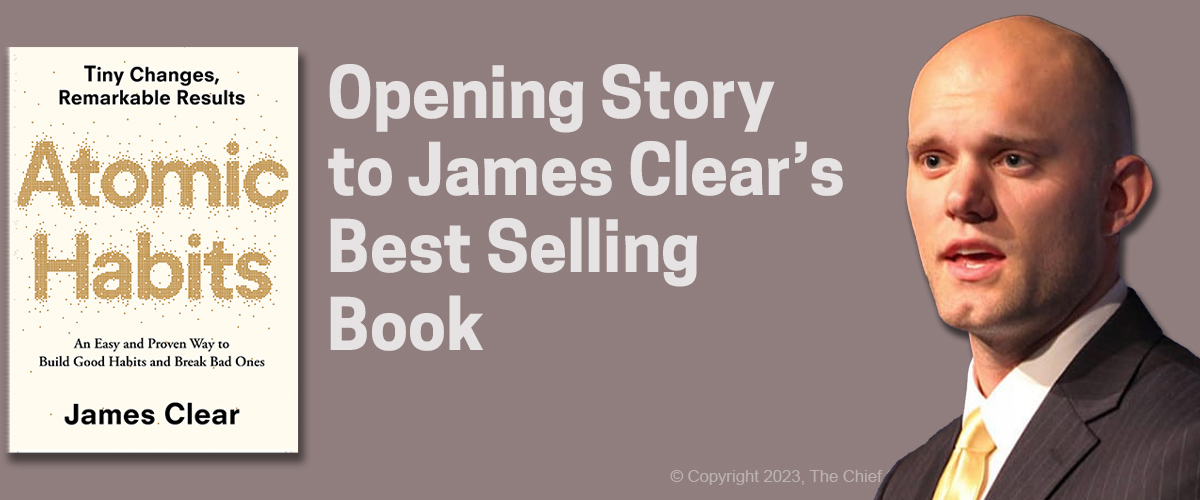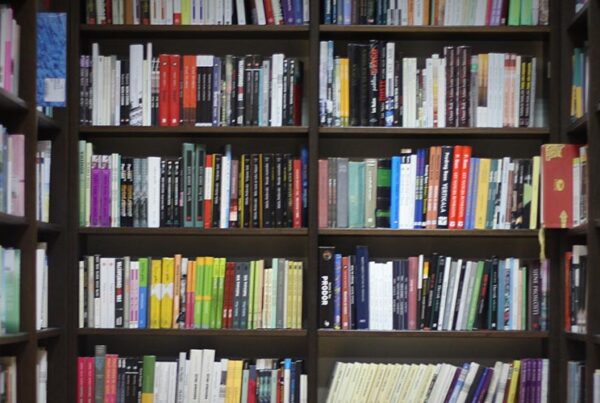
I’ve been working with Alex, one of my executive coaching and storytelling/marketing clients, for the past several years. Early in the engagement, I helped him tell an important life story of his, that was in part, due to his following James Clear’s advice of making 1% improvements. James Clear’s best selling Atomic Habits centers on the concept of making marginal gains, that when compounded, make substantial gains.
In the last year, for Alex’s company, 1% Improvements has become a company value, a company mantra, and a company way of life.
The way it has changed his employee’s thinking and his bottom line, inspired me to read Atomic Habits. James Clear’s story of how he embraced habits is compelling. And he shares his story in the very beginning.
It is an excellent story with all of the right story elements. Examples include:
- Compelling opening
- Very personal and challenging
- Interesting inner dialogue
- Interesting character dialogue
- Figures of Speech, especially figures of repetition (e.g., Diacope)
- Inspiring business message, what we call your Better Tomorrow Message™ (“Fulfill your potential with small habits”)
- Good flow
- Clear beginning, middle, and end
- Compelling call-to-action at the end
Most book authors share stories that are lengthier than if spoken. A typical business story is about three minutes, which is about 450 words spoken at a normal pace. Clear’s introductory story in Atomic Habits is about 12 minutes if spoken, and to read, about 8 minutes. As a result, I have reduced the story narrative to about five minutes, by reducing the details. Of course, you can read the entire story in the book, Atomic Habits.
Atomic Habits Story: Fulfill Your Potential with Small Habits
On the final day of my sophomore year of high school, I was hit in the face with a baseball bat. As my classmate took a full swing, the bat slipped out of his hands and came flying toward me before striking me directly between the eyes. I have no memory of the moment of impact.
The bat smashed into my face with such force that it crushed my nose into a distorted U-shape. The collision sent the soft tissue of my brain slamming into the inside of my skull. Immediately, a wave of swelling surged throughout my head. In a fraction of a second, I had a broken nose, multiple skull fractures, and two shattered eye sockets. I was unaware of how seriously I had been injured.
When we arrived at the nurse’s office, she asked me a series of questions.
- “What year is it?”
- “1998,” I answered. It was actually 2002.
- “Who is the president of the United States?”
- “Bill Clinton,” I said. the correct answer was George W. Bush.
- “What is your mom’s name?”
- “Uh. Um.” I stalled. Ten seconds passed. “Patti,” I said casually, ignoring the fact that it had taken me ten seconds to remember my own mother’s name.
That is the last question I remember. My body was unable to handle the rapid swelling in my brain and I lost consciousness.
When my mom and I landed on the roof of the hospital, a team of nearly twenty doctors and nurses sprinted onto the helipad and wheeled me into the trauma unit. By this time, the swelling in my brain had become so severe that I was having repeated post-traumatic seizures.
After yet another seizure—my third of the day—I was put into a medically induced coma and placed on a ventilator. While I slipped into a coma, the hospital sent a priest and a social worker to comfort my parents. As the day faded into night, a series of machines kept me alive. My mother would tell me later, “It was one of the worst nights I’ve ever had.”
MY RECOVERY
Mercifully, by the next morning my breathing had rebounded to the point where the doctors felt comfortable releasing me from the coma. The following months were hard. It felt like everything in my life was on pause. I had double vision for weeks; I literally couldn’t see straight. Between the seizures and my vision problems, it was eight months before I could drive a car again.
I became painfully aware of how far I had to go when I returned to the baseball field one year later. Baseball had always been a major part of my life. My dad had played minor league baseball for the St. Louis Cardinals, and I had a dream of playing professionally, too. After months of rehabilitation, what I wanted more than anything was to get back on the field.
But my return to baseball was not smooth. When the season rolled around, I was the only junior to be cut from the varsity baseball team. I was sent down to play with the sophomores on junior varsity. I had been playing since age four, and for someone who had spent so much time and effort on the sport, getting cut was humiliating. I vividly remember the day it happened. I sat in my car and cried as I flipped through the radio, desperately searching for a song that would make me feel better.
After a year of self-doubt, I managed to make the varsity team as a senior, but I rarely made it on the field. In total, I played eleven innings of high school varsity baseball, barely more than a single game.
Despite my lackluster high school career, I still believed I could become a great player. And I knew that if things were going to improve, I was the one responsible for making it happen. The turning point came two years after my injury, when I began college at Denison University. It was a new beginning, and it was the place where I would discover the surprising power of small habits for the first time.
HOW I LEARNED ABOUT HABITS
Attending Denison was one of the best decisions of my life. I earned a spot on the baseball team and, although I was at the bottom of the roster as a freshman, I was thrilled. Despite the chaos of my high school years, I had managed to become a college athlete.
I wasn’t going to be starting on the baseball team anytime soon, so I focused on getting my life in order. While my peers stayed up late and played video games, I built good sleep habits and went to bed early each night. In the messy world of a college dorm, I made a point to keep my room neat and tidy. These improvements were minor, but they gave me a sense of control over my life. I started to feel confident again.
And this growing belief in myself rippled into the classroom as I improved my study habits and managed to earn straight A’s during the rest of the year.
A habit is a routine or behavior that is performed regularly—and, in many cases, automatically. As each semester passed, I accumulated small but consistent habits that ultimately led to results that were unimaginable to me when I started. For example, for the first time in my life, I made it a habit to lift weights multiple times per week, and in the years that followed, my six foot-four-inch frame bulked up from a featherweight 170 to a lean 200 pounds.
When my sophomore season arrived, I earned a starting role on the pitching staff. By my junior year, I was voted team captain and at the end of the season, I was selected for the all-conference team. But it was not until my senior season that my sleep habits, study habits, and strength-training habits really began to pay off.
Six years after I had been hit in the face with a baseball bat, flown to the hospital, and placed into a coma, I was selected as the top male athlete at Denison University and named to the ESPN Academic All-America Team— an honor given to just thirty-three players across the country. By the time I graduated, I was listed in the school record books in eight different categories. During the same year, I was awarded the university’s highest academic honor, the President’s Medal.
Looking back on those years, I believe I accomplished something just as rare: I fulfilled my potential.
HOW THIS BOOK WILL BENEFIT YOU
And I believe the concepts in this book can help you fulfill your potential as well.
We all face challenges in life. This injury was one of mine, and the experience taught me a critical lesson: changes that seem small and unimportant at first will compound into remarkable results if you’re willing to stick with them for years. We all deal with setbacks but in the long run, the quality of our lives often depends on the quality of our habits. With the same habits, you’ll end up with the same results. But with better habits, anything is possible.
It was a gradual evolution, a long series of small wins and tiny breakthroughs. The only way I made progress—the only choice I had—was to start small. Small habits helped me fulfill my potential, and since you picked up this book, I’m guessing you’d like to fulfill yours as well.
MORE EXCELLENT BUSINESS STORIES TO READ
- Stop Blaming Steve, from Brene Brown (read/watch)
- Stick To Your Own Convictions, From John Zimmer, Lyft (read)
- Don’t Be The Idiot In The Red Convertible – Story (read)
- All story examples (go now)
FURTHER READING ON BUSINESS STORYTELLING
- Turn Your Everyday Experiences into Engaging, Powerful Stories (read)
- “Pause” with Purpose in Speaking, Training, and Storytelling (read)
- In Storytelling, Balance Emotion and Benefit (read)
- Add Suspense to Your Story with “Near-Impossible Goals” (read)
- Anaphora – Increase Impact with this Type of Word Repetition (read)
- All Business Storytelling Articles & Posts (go now)
Photography Source: Headshot, James Clear, Atomic Habits. Designed by The Chief Storyteller®, LLC. © Copyright 2023. All Rights Reserved.
#chiefstoryteller #storytelling #atomichabits #leaders #storytellingforleaders



